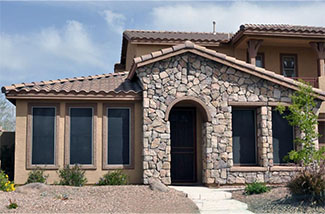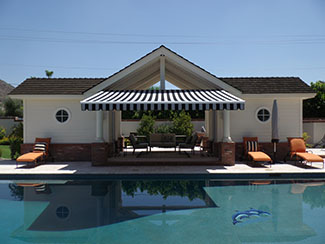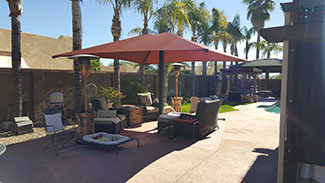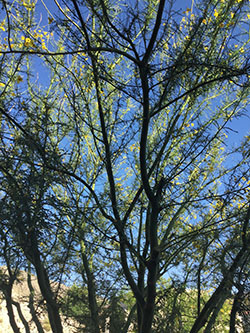Great Ways to Fight the Sun in Arizona
 13 March 2018
13 March 2018 

Battle the Summer Heat With Shade
We all enjoy the climate in Central and Southern Arizona between October and May, but the sizzling summer heat can be challenging. We've been talking lately about how new windows in Arizona homes can provide a more comfortable home in the hot season. But there are other possibilities for cooling house and yard you might not have thought about:

Sunscreens
These screens, made of polyester with a vinyl coating, are a low-cost, efficient way to stop 80 percent or more of the heat and UV rays coming through your windows. They are not like the screens that stop bugs from flying in the house. In order to work effectively, the screens also should not touch the glass in your windows.
Many homeowners may hesitate to buy screens for fear that they can block the view of a beautiful mountain or golf course, but the difference in the scenery will be very small. The screens will actually dim your view less if they're coated in a dark brown or black shade. "It's
harder to look out and see the view if you're looking through the lighter colored screens," Richard Tomes of Arizona Screen Techs says.

Although it's possible to take off the screens and store them in winter to let more light in the house, most homeowners don't bother to do that, according to Del Paul of Arizona Sun Screen. The latest polyester-PVC sunscreens are extremely long-lasting and are unlikely to lose their shape and start sagging.
Customers who get power from SRP (Salt River Project) are eligible for a credit based on the square footage of screens placed on their house. In addition, there will be savings on monthly utility bills for less air conditioning that will help pay for the screens. The greater the number of large windows you have, the more money you save. An older home with few windows and lots of overhangs that shade the house will not benefit as much. "But even homes with newer replacement windows will benefit from having sunscreens," Tomes says.
Fabric awnings
If you have a handful of windows that need shading, fabric awnings can be an economical solution. They can be designed to set off the architecture of your home whether it's a pueblo style or contemporary design or a Santa Barbara look. A single awning can reduce the heat coming through the window from the west by 77 percent or from the south by 65 percent.

About 30 to 40 years ago, lateral arm-extruded arm retractable awnings became available. So now, when they're not needed, awnings can be closed manually via a hand crank or can be closed automatically if they are motorized by pushing a button or setting a timer.
Roll curtains that roll up and down
These types of mesh or Sunbrella curtains are perfect for covered patios. A giant shade curtain can be rolled down at dinner time to provide shelter on a patio that gets intense heat from the west side. Or maybe, you need that kind of shade for your morning coffee on the east side of the patio. They can also be designed to roll up when it gets windy outside. These shades can also be controlled by a rope and pulley, a hand crank or a motor.

Shade sails and umbrellas
Some customers like the idea of shade sails – large pieces of mesh fabric stretched out and fastened on posts driven into the ground. The shade from the sail can shelter swimmers in a pool or diners at an outdoor table. But the number of posts and the depth that they must be driven into the ground or concrete can make this option costly, Gallegos says. Costs can vary on sails and installation of posts in ground. He recommends installing a stationary umbrella sail instead that can be mounted to an existing slab.
Shade trees
Strategically placed trees can reduce your air conditioner use, according to the U.S. Department of Agriculture. If you plant a tree today on the west side of your home, in five years your energy bills should be 3 percent less, and in 15 years, the savings will be nearly 12 percent, according to the Center for Urban Forest Research.
Many trees that do best in the Phoenix and Tucson area are native mesquites and Palo Verde's that only reach a height of 30 feet or so. They grow quickly and can provide a lot of shade. But if you're looking for more vertical growth, there are many taller trees from elsewhere that can grow well in the desert including ash, elm, pistache and oak trees.
###
Photo Credits:
RELATED CONTENT:
- Blog: Six Things You Need To Know About New Windows
- Blog: Are You Missing Real Good Deals From Our Utility Companies?
- Blog: Six Common AC Problems That Can Be Fixed
- DIY Q&A: How close can I plant trees to my home?
- Podcast: Window Treatments
Print this page
recent post
- Duck, Duck, Duct! How Often Should Ductwork Be Cleaned?
- Vinyl vs. Fiberglass Windows: Which Is The Better Choice Of Replacement Window?
- We May Be The Grand Canyon State, But The Rocky Mountains Are Important For Arizona
- Welcome to Arizona! Things A Newbie to Arizona Should Know
- The Pros & Cons of Buying A Flipped House
- Getting In On The Ground Floor
- Why It’s More Critical Than Ever To Get Your AC Serviced Before Summer
- The Reality of Remodeling
- What To Look For When Comparing Your Roofing Quotes
- What To Expect When Buying New Windows & Doors
